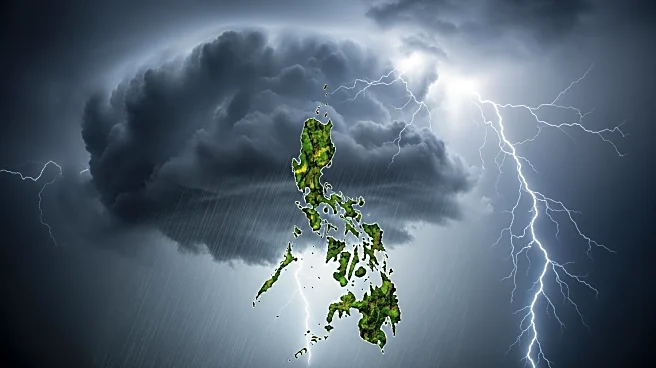What's Happening?
The Philippines' weather bureau has issued a warning about life-threatening storm surges and destructive winds as Typhoon Fung-wong approaches the country's eastern coast. The typhoon is expected to intensify
into a super typhoon before making landfall on Sunday night. Currently, Fung-wong is packing maximum sustained winds of 140 kph and gusts up to 170 kph, with potential intensification to 185 kph. The storm's massive circulation spans 1,500 kilometers, affecting parts of the eastern Philippines with heavy rains and winds. Up to 200 mm of rainfall is anticipated in eastern provinces, particularly in the Bicol region and parts of Samar, raising the risk of flooding and landslides. Northern and central Luzon could also experience significant rainfall during the storm's passage. Residents in low-lying and coastal areas are urged to evacuate to higher ground, and marine activities have been halted.
Why It's Important?
The warning comes shortly after Typhoon Kalmaegi caused significant destruction in the region, killing 204 people in the Philippines and five in Vietnam, displacing hundreds of thousands, and causing widespread power outages. The Philippines and Vietnam are particularly vulnerable to tropical storms due to their locations along the Pacific typhoon belt. The potential impact of Typhoon Fung-wong could exacerbate existing damage and strain recovery efforts. The storm's intensification and widespread impact highlight the increasing severity of tropical storms, which scientists attribute to rising global temperatures. The situation underscores the need for effective disaster preparedness and response strategies in regions prone to such natural disasters.
What's Next?
Local governments have suspended classes for Monday, and the Philippines' flag carrier has canceled some flights in anticipation of the typhoon's landfall. Residents are being evacuated, and emergency services are on high alert to manage potential flooding and landslides. The ongoing recovery from Typhoon Kalmaegi adds complexity to the response efforts, as resources may be stretched thin. The international community may need to provide support to affected areas, particularly in terms of humanitarian aid and infrastructure rebuilding. Monitoring the storm's progression and impact will be crucial in mitigating further damage and ensuring the safety of residents.
Beyond the Headlines
The increasing intensity of tropical storms like Fung-wong and Kalmaegi raises concerns about climate change and its impact on weather patterns. As global temperatures rise, storms are becoming more powerful, posing greater risks to vulnerable regions. This trend necessitates a reevaluation of climate policies and disaster management strategies to better protect communities and infrastructure. The situation also highlights the importance of international cooperation in addressing climate-related challenges and supporting affected countries in their recovery efforts.












